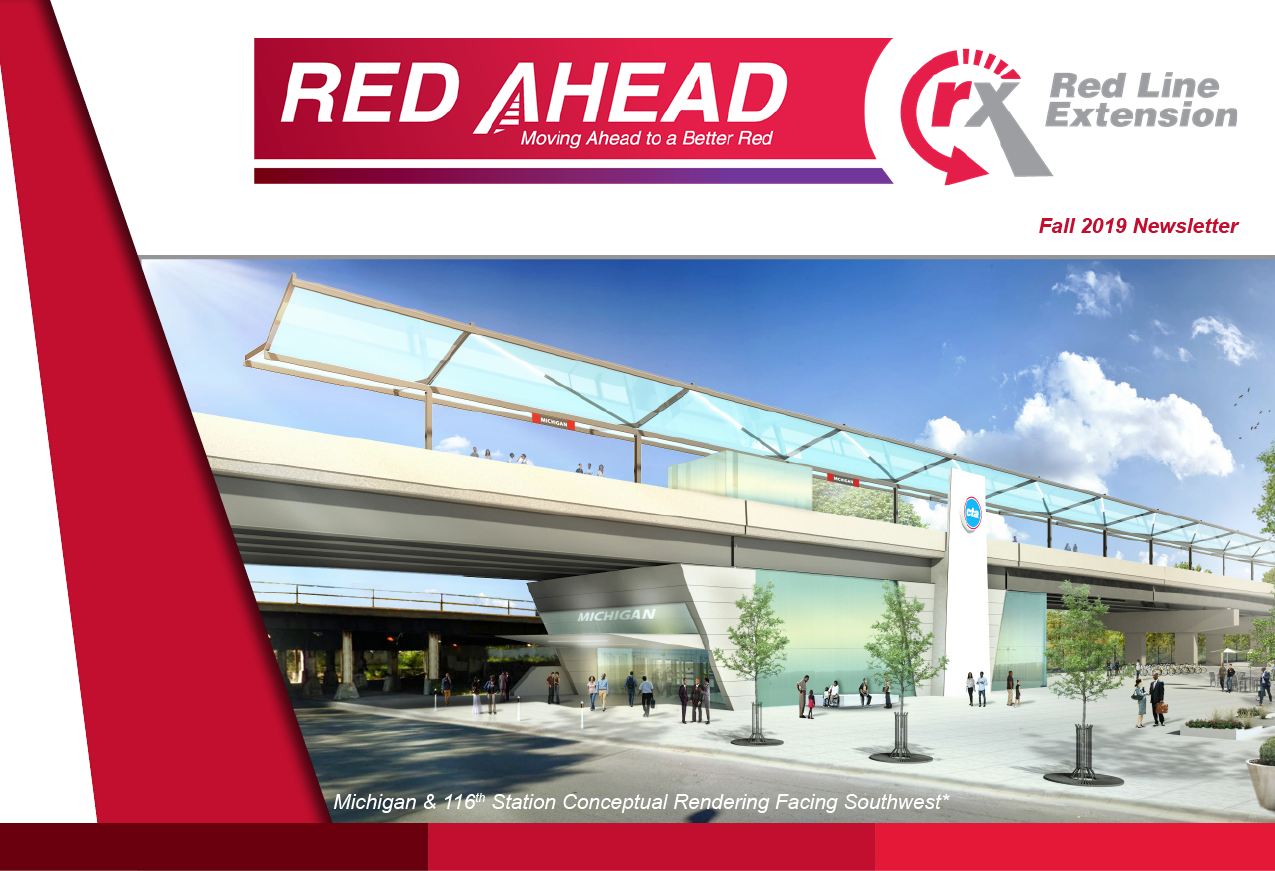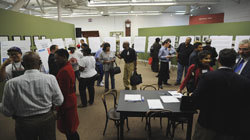Chicago City Council approves Transit TIF to support the RLE
A new Transit Tax Increment Financing (TIF) district approved by City Council will provide financial support for the $3.6 billion extension of the Chicago Transit Authority (CTA) Red Line from 95th Street to 130th Street on the Far South Side.
The adopted Transit TIF legislation will generate up to $959 million in local funds for eligible costs involving RLE construction and administration.
CTA news release (12/14/2022)
CTA Red Line Extension Project receives ‘Record of Decision’; helping long-awaited project advance to next planning phase
The Federal Transit Administration (FTA) and the CTA, in cooperation with the Federal Highway Administration (FHWA), announced the publication of the combined Final Environmental Impact Statement (EIS)/Record of Decision (ROD) and Final Section 4(f) Evaluation for the RLE Project on August 12, 2022.
The ROD is the conclusion of the National Environmental Policy Act (NEPA) EIS process and is the official FTA decision document regarding the project’s environmental impacts and mitigation.
CTA news release (8/15/2022)
RLE Transit Tax Increment Financing (TIF) Public Meeting
The Chicago Transit Authority (CTA) hosted a public meeting to discuss a proposed Transit Tax Increment Financing (TIF) district designation for the Red Line Extension (RLE) Project. The public meeting included a presentation by CTA and City of Chicago representatives followed by a comment period, during which members of the public asked questions and provided input on the proposed Transit TIF.
Date: Thursday, July 21, 2022
Time: Doors open at 5:00 p.m.(In-Person), presentation and Zoom webinar began at 5:30 p.m.
Location: Harold Washington Library Center, lower level (400 S. State St., Chicago, IL 60605)
Visit the RLE Transit TIF webpage to learn more or view the webinar recording.
*Face masks are recommended.
Diversity Programs Construction Management Outreach Event
Attend the Chicago Transit Authority (CTA) Diversity Programs outreach event for Construction Management (CM) opportunities. Network with potential prime contractors and other DBE firms to build relationships for upcoming contracts. Attendees will also learn about Red Line Extension (RLE) contracting opportunities.
Date: April 4, 2022
Time: 10:00 a.m. to 12:00 noon
Location: Salvation Army Kroc Center - 1250 W 119th St, Chicago IL 60643
*Masks are required to enter.
For more information, please contact: Diversity@transitchicago.com
Virtual workshop regarding upcoming contracting opportunities
March 16, 2022
Owners of minority- and women-owned businesses interested in in becoming vendors and suppliers for upcoming contract opportunities under the proposed Red Line Extension (RLE) project, are strongly encouraged to view this webinar. During this webinar, CTA officials discuss anticipated timelines for design and construction of the RLE project, the procurement timeline and opportunities for DBEs. Although the proposed RLE project is still in development, there are plenty of prospects for robust DBE participation in the next steps of the project.
Watch the webinar on YouTube here.
RLE Supplemental Environmental Assessment and Section 4(f) public hearings and comments
The Federal Transit Administration (FTA) and the CTA announced the availability of the Supplemental Environmental Assessment (EA) and Section 4(f) Evaluation for the Red Line Extension (RLE) Project.
In 2020, a Supplemental EA was determined to be required for the RLE project to evaluate the three project changes that have occurred since the publication of the Draft Environmental Impact Statement (EIS) in 2016. The project changes are 1) 130th Street station relocation, 2) 120th Street yard and shop refinement, and 3) 107th Place cross-over.
The CTA accepted comments on the Supplemental EA and Section 4(f) Evaluation from January 31, 2022 through March 1, 2022. This period has now concluded and the CTA thanks everyone who submitted a comment or provided feedback. The FTA and the CTA will review the comments received during the public comment period and will address all comments in the Final EIS.
The goal of these hearings was to allow members of the public an opportunity to provide feedback and input on the potential impacts the proposed Red Line Extension project may have on the areas surrounding the project footprint.
The CTA hosted a virtual and in-person public hearing at the Salvation Army Kroc Center to solicit public comments. For past meeting material, click here.
CTA news release (2/10/2022)
RLE Transit-Supportive Development (TSD) in-person office hours
The CTA hosted in-person office hours following the final TSD virtual community meetings to provide community members the opportunity to meet with project staff, ask questions, and have engaging discussions about the RLE project and the TSD Plan.
- Thursday, December 9th, 2021
- 103rd Street Station (10:00 a.m. - 12:00 p.m.)
Location: Victory City Campus (10116 S. Normal Ave, Chicago, IL)
- Michigan Avenue Station (1:30 p.m.- 3:30 p.m.)
Location: New Christian Joy MB Church (11594 S. State St, Chicago, IL)
- Friday, December 10th, 2021
- 111th Street Station (10:00 a.m. -12:00 p.m.)
Location: Agape Community Center (342 W 111th St, Chicago, IL)
- 130th Street Station (1:30 p.m.– 3:30 p.m.)
Location: Altgeld Public Library (955 E 131st St, Chicago, IL)
Final RLE Transit-Supportive Development (TSD) community meetings
The CTA hosted two virtual meetings to get feedback on the proposed strategies and concepts for Transit-Supportive Development near each of the four proposed RLE station areas. The input of the community will help determine the preferred, future development of the station areas.
-
Tuesday, December 7th, 2021 (6 p.m. – 7:30 p.m.)
103rd Street & Michigan Avenue station areas
-
Wednesday, December 8th, 2021 (6 p.m. – 7:30 p.m.)
111th Street & 130th Street station areas
Click here to learn more about the TSD Plan.
For past meeting materials, click here.
Virtual community meeting scheduled for the RLE Transit Supportive Development Plan
The CTA hosted two identical virtual meetings to get feedback on the draft vision statements developed with guidance from the community for the areas around the new stations. The project team shared what was learned from the community at the four station area meetings earlier this year. The meetings also included a planning exercise to brainstorm different types of potential future development near each station.
- Wednesday, May 5, 2021 (2:30 p.m. – 4:00 p.m.)
- Thursday, May 6, 2021 (6:00 p.m. – 7:30 p.m.)
For past meeting materials, click here.
RLE virtual station area meetings
The CTA hosted a series of virtual public meetings to discuss project progress and the community's vision for the areas around the four proposed stations for the Red Line Extension (RLE) project. Community input will help determine the needs and priorities for future development around each station area as part of the RLE Transit-Supportive Development Plan.
- 130th Street | Wednesday, January 27, 2021 (6:00 p.m. – 7:30 p.m.)
- 111th Street | Tuesday, February 2, 2021 (6:00 p.m. – 7:30 p.m.)
- 103rd Street | Tuesday, February 9, 2021 (6:00 p.m. – 7:30 p.m.)
- Michigan Avenue | Tuesday, February 16, 2021 (6:00 p.m. – 7:30 p.m.)
For past meeting materials, click here.
RLE Receives Federal Transit Administration approval to enter Project Development Phase
The CTA’s Red Line Extension project has received approval from the Federal Transit Administration to enter the Project Development phase of the Capital Investment Grants (CIG) Program as a New Starts project. Entering this phase is a major step in the CTA’s continued commitment to advance the RLE project. Project Development is one of a series of steps required by federal transit law for transit agencies seeking CIG funding.
During the two-year Project Development phase, the CTA will complete the project’s Final Environmental Impact Statement (EIS) and preliminary engineering documents to successfully meet the federal requirements for this phase.
CTA news release (12/21/2020)
Virtual community meetings for RLE
The CTA hosted two identical virtual community meetings on Tuesday, December 8, 2020, and Wednesday, December 9, 2020 to provide updates on the RLE project and an introduce to the RLE Transit-Supportive Development (TSD) plan. The meeting was available in English and Spanish, in addition to American Sign Language and English closed captions. To learn more visit www.transitchicago.com/RLE/TSD/
For past meeting materials, click here.
New RLE video and Facebook page
Watch the video (with captions in English or Spanish) to learn more about the Red Line Extension project and the CTA’s commitment to improve mobility, accessibility and economic opportunity throughout Chicago. Plus, the CTA now has a Facebook page devoted to the RLE Project: Facebook.com/CTARedExt! This page is a convenient resource for you to learn more about the project and engage with the RLE project team. The RLE Facebook page is available to everyone whether or not you have a Facebook account.
Consultant team approved for next step of RLE project
The Chicago Transit Board approved a $38.3 million contract to T. Y. Lin International Great Lakes, Inc. to provide planning and preliminary engineering services for the Red Line Extension (RLE) project, including preparation of the project’s Final Environmental Impact Statement (EIS) and preliminary engineering documents. The work included under this contract will allow the RLE project to advance through the Project Development phase, which is the next step of the federal funding process.
The Final EIS will include and address all comments received during the public review period for the Draft EIS, which was completed in 2016. The Final EIS will document the results of the Draft EIS process, confirm the Preferred Alignment, and include a list of final improvement measures to address any environmental impacts to the surrounding community. Preliminary engineering will advance the project’s design to 30%, which is also a requirement of the Project Development phase.
T.Y. Lin International has committed to meeting a Disadvantaged Business Enterprise goal of 26 percent.
CTA news release (2/10/2020)
Fall 2019 outreach
The CTA staff met with several community stakeholder groups to discuss the latest updates and next steps on the RLE project. All stakeholders agreed with the need for greater connectivity and easy access to information about the RLE Project throughout this process. They also offered their continued assistance on sharing project updates from the CTA within their community.
To request a project briefing or to invite the CTA to speak about the RLE Project at an upcoming event, please contact RedExtension@transitchicago.com.
The CTA commits $310M for RLE
The CTA’s 2020 capital budget included a commitment to invest $310 million to extend the Red Line to 130th Street. This is the single most significant funding contribution that the CTA has ever made towards the RLE project and will fund engineering and design work needed to position the project to receive federal funding.
The 2020 Budget Recommendations book is available here on the CTA's Finance & Budget webpage.
Fall 2019 Newsletter

RLE receives $1.48M grant from FTA
The RLE project received a $1.48 million grant for comprehensive local planning efforts through the FTA’s Pilot Program for Transit-Oriented Development (TOD) Planning. Comprehensive planning funded through the program will examine, among other things:
- Ways to improve economic development and ridership
- Foster multimodal connectivity and accessibility
- Improve transit access for pedestrian and bicycle traffic
- Engage the private sector
- Identify infrastructure needs, and
- Enable mixed-use development along the RLE corridor
FTA news release (12/18/2018)
Selection of new RLE Program Manager
In December 2018, the Chicago Transit Board approved the award of the RLE Program Management Contract to HNTB Corporation. The RLE Program Manager will oversee the final environmental analysis and preliminary engineering work that is necessary to secure federal funding for the RLE project.
CTA news release (12/12/2018)
Public open house scheduled for the RLE Preferred Alignment
The CTA hosted a public open house on Tuesday, February 13, 2018 at Gwendolyn Brooks College Preparatory Academy to provide information on the Preferred Alignment for the RLE Project. The meeting location was ADA compliant and accessible by public transit.
This meeting was conducted in an open house format. The CTA welcomed comments and feedback about the Preferred Alignment and potential impacts.
View the exhibit boards (2/13/2018)
The CTA selects a Preferred Alignment for RLE
In fall 2016, the CTA published a Draft Environmental Impact Statement (EIS) and held a public hearing on Tuesday, November 1, 2016 at St. John Missionary Baptist Church to obtain comments on the benefits and impacts of two options that were under consideration for the Red Line Extension (RLE) Project alignment—the East Option and the West Option.
In 2018, based on public and agency feedback received on the Draft Environmental Impact Statement (EIS) as well as subsequent project planning and engineering work, the CTA selected the Preferred Alignment for the RLE project. The Preferred Alignment is a combination of the previously presented Union Pacific Railroad (UPRR) East and West Option and would run along the west side of the Union Pacific Railroad tracks (from I-57 south to approximately 108th Place, later refined to 107th Place), cross over the Union Pacific Railroad tracks and run along the east side of the tracks until crossing the Metra Electric tracks (near 119th Street) and continue south to 130th Street. (See the project map.)
The Preferred Alignment captures the benefits and minimizes the impacts of either option. The Preferred Alignment would affect fewer residences than the East Option and fewer businesses and jobs than the West Option. Noise and vibration impacts as a result of the Preferred Alignment would not be greater than those anticipated under either the East or West options.
CTA news release (1/26/2018)
$75 million investment in RLE announced
On November 27, 2016, then-Mayor Emanuel and the CTA announced that the Chicago Transit Board approved an amendment to its FY2016-FY2020 Capital Improvement Plan to include $75 million in funding for the RLE project to extend Red Line rail service to 130th Street from 95th Street. This project includes four new rail stations on Chicago’s Far South Side.
CTA news release (11/27/2016)
RLE Draft EIS
The CTA and the Federal Transit Administration (FTA) prepared a Draft EIS based on the technical analysis of impacts of the previously considered project alternatives. The Draft EIS documents the benefits and impacts of the alternatives under consideration, which includes impacts to parks and wetlands.
The Draft EIS is available here.
Draft EIS public hearing and comments


The CTA hosted a public hearing on Tuesday, November 1, 2016 at St. John Missionary Baptist Church to provide information about the Draft EIS and solicit comments from the public. The meeting location was ADA compliant and accessible by public transit.
This meeting was conducted in an open house format. The public was invited to provide comments on the Draft EIS either verbally to a court reporter or in writing during the public hearing.
Comments on the Draft EIS were accepted from October 6 to November 30, 2016, and the CTA thanks everyone who submitted a comment or provided feedback. The FTA and the CTA will review the comments received during the public comment period and will address all comments in the Final EIS.
View exhibit boards